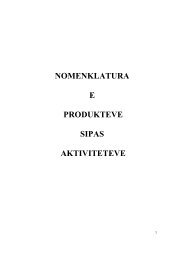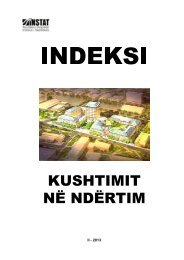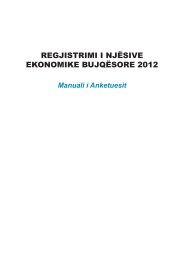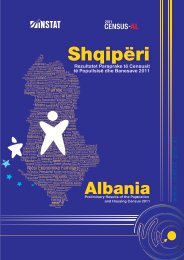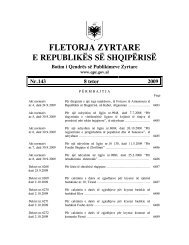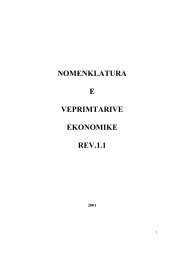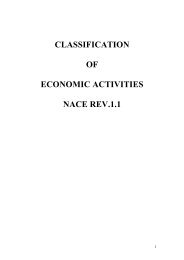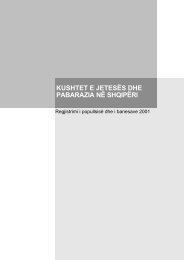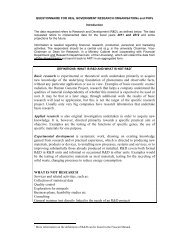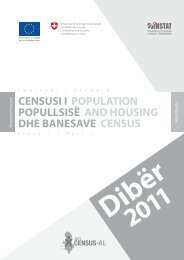Description of methods and sources for Albania - INSTAT
Description of methods and sources for Albania - INSTAT
Description of methods and sources for Albania - INSTAT
- No tags were found...
Create successful ePaper yourself
Turn your PDF publications into a flip-book with our unique Google optimized e-Paper software.
IPA 2009 Multi-beneficiary StatisticalCooperation Programmereason why we have not included this data has to do with the kind <strong>of</strong> deflators thatcan be used.18.1.7 Ministry <strong>of</strong> Agriculture <strong>and</strong> Food (MAF)This Ministry provides data <strong>for</strong> <strong>INSTAT</strong> classified in products’ level, which are lateraggregated <strong>and</strong> estimated from the agriculture sector <strong>of</strong> <strong>INSTAT</strong>. This data is givenon a quarterly basis <strong>and</strong> is available to the needs <strong>of</strong> our sector 55-60 days after therespective quarter has finished. This data is available to the agricultural sector <strong>of</strong><strong>INSTAT</strong> after 25-30 days <strong>and</strong> this sector is responsible <strong>for</strong> a quarterly estimation atcurrent <strong>and</strong> constant prices.18.2 MethodologyThe methodology used considers the development <strong>of</strong> quarterly series <strong>of</strong> GDP atcurrent <strong>and</strong> constant prices. The series in constant prices are based upon fixed,2005=100, prices. The basis <strong>for</strong> this methodology is to follow the presentmethodology <strong>for</strong> the annual accounts GDP as closely as possible, <strong>and</strong> to ensure thatthe annual movements derived from the quarterly series exactly match the publishedannual series at both current <strong>and</strong> constant prices. The method used to estimate QGDPis considered as an indirect method. When a direct method is used, we estimateoutput <strong>and</strong> intermediate consummation separately, <strong>and</strong> we produce from them thevalue added as a difference. When an indirect method is used, we have only somequarterly indicators which can provide value or volume indicators, from which weproduce value added. We get annual value added <strong>and</strong> quarter indicators, based onwhich we make benchmarking process. There<strong>for</strong>e, these are used as outputindicators.VAT data instead <strong>of</strong> STS data are used by most <strong>of</strong> branches. This data has proven tobe more reliable than <strong>INSTAT</strong>’s STS <strong>and</strong> it has greater coverage <strong>and</strong> response rates.This is not the ideal situation because changes in administrative procedures couldquickly change <strong>and</strong> invalidate quarterly movements. Based on an analysis conducted,it was found that activity classifications change over time, some months <strong>of</strong> data aremissing <strong>for</strong> continuing enterprises <strong>and</strong> large data entry errors were fairly common.With regard to the classification issue, we have concluded to solve this problem byusing the classification that the enterprises have at their balance sheet if this oneexists.For example, <strong>for</strong> 2008 we have the balance sheet <strong>of</strong> 2007 which means that by theend <strong>of</strong> this year the enterprises will have this classification. For those enterpriseswhere the balance sheet do not exist, we see if the data in the annual surveys is there,<strong>and</strong> if it is there we put this classification, <strong>and</strong> if not, we leave the existingclassification at the declaration <strong>for</strong>mat <strong>of</strong> Tax Authorization. For the period that theannual data do not exist, we put the classification <strong>of</strong> the quarterly survey if theenterprise exists, <strong>and</strong> if not, we leave it unchanged. When these <strong>for</strong>ms <strong>of</strong>classifications were applied to the VAT data, the volatility <strong>of</strong> data <strong>for</strong> most industrieswas significantly reduced.162/236



